Fluid Inclusion Studies of Barite Disseminated in Hydrothermal Sediments of the Mohns Ridge
Abstract
:1. Introduction
2. Geological Setting
3. Materials and Methods
3.1. Study Area
3.1.1. Jan Mayen AVR at 71°18′ N and Related Hydrothermal Systems
3.1.2. The AVR at 73°30′ N and 8° E and Related Hydrothermal System
3.2. Field Observations and Sample Collection
3.3. Petrography and Mineralogy
3.4. XRF Analysis
3.5. Sample Preparation and Fluid Inclusion Petrography
3.6. Fluid Inclusion Microthermonetry
4. Results
4.1. Temperature and Salinity of Ambient Seawater
4.2. Petrography of Basaltic Rocks and Lithology of Hydrothermal Sediments
4.3. Mineralogy of Hydrothermal Sediments
4.4. Wholerock Composition and Dominant Trace Elements
4.5. Barite Chrystal Morphology, Size, and EDS Data
4.6. Study of Fluid Inclusions
5. Discussion
5.1. Characterization of the Bottom Water Layer at the Hydrothermal Vent Fields
5.2. Specificity of Hosted Volcanogenic Deposits
5.3. Controls on Barite Mineralization in Hydrothermally Altered Sediments
5.4. Features of Hydrothermal Systems on the Mohns Ridge: Evidence from Fluid Inclusions Hosted in Barites
5.4.1. Troll Wall Vent Field
5.4.2. Perle and Bruse Vent Field
5.4.3. Loki’s Castle Vent Field
5.4.4. Comparative Study of Fluid Inclusions Hosted in Hydrothermal Barites from the Mohns Ridge with Similar Products from Other Hydrothermal Systems
6. Conclusions and Perspectives
Supplementary Materials
Author Contributions
Funding
Data Availability Statement
Acknowledgments
Conflicts of Interest
References
- Griffith, E.M.; Paytan, A. Barite in the ocean—Occurrence, geochemistry and paleoceanographic applications. Sedimentology 2012, 59, 1817–1835. [Google Scholar] [CrossRef]
- Chow, T.J.; Goldberg, E.D. On the marine geochemistry of barium. Geochim. Cosmochim. Acta 1960, 20, 192–198. [Google Scholar] [CrossRef]
- Horner, T.J.; Pryer, H.V.; Nielsen, S.G.; Crockford, P.W.; Gauglitz, J.M.; Wing, B.A.; Ricketts, R.D. Pelagic barite precipitation at micromolar ambient sulfate. Nat. Commun. 2017, 8, 1342. [Google Scholar] [CrossRef] [PubMed]
- Horner, T.J.; Little, S.H.; Conway, T.M.; Farmer, J.R.; Hertzberg, J.E.; Janssen, D.J.; Lough, A.J.M.; McKay, J.L.; Tessin, A.; Galer, S.J.G.; et al. Bioactive Trace Metals and Their Isotopes as Paleoproductivity Proxies: An Assessment Using GEOTRACES-Era Data. Glob. Biogeochem. Cycles 2021, 35, e2020GB006814. [Google Scholar] [CrossRef]
- Paytan, A.; Mearon, S.; Cobb, K.; Kastner, M. Origin of marine barite deposits: Sr and S isotope characterization. Geology 2002, 30, 747–750. [Google Scholar] [CrossRef]
- Lein, A.Y.; Kravchishina, M.D. Barium Geochemical Cycle in the Ocean. Lithol. Miner. Resour. 2021, 56, 293–308. [Google Scholar] [CrossRef]
- Martinez-Ruiz, F.; Paytan, A.; Gonzalez-Muñoz, M.T.; Jroundi, F.; Abad, M.M.; Lam, P.; Bishop, J.; Horner, T.; Morton, P.; Kastner, M. Barite formation in the ocean: Origin of amorphous and crystalline precipitates. Chem. Geol. 2019, 511, 441–451. [Google Scholar] [CrossRef]
- Dean, W.E.; Schreiber, B.C. Marine Evaporites; S.E.P.M. Short Course 4; Society of Economic Paleontologists and Mineralogists: Oklahoma City, OK, USA, 1978; 188p. [Google Scholar]
- Von Damm, K.L. Seafloor hydrothermal activity: Black smoker chemistry and chimneys. Annu. Rev. Earth Planet. Sci. 1990, 18, 173–204. [Google Scholar] [CrossRef]
- Tivey, M.K. Generation of seafloor hydrothermal vent fluids and associated mineral deposits. Oceanography 2007, 20, 50–65. [Google Scholar] [CrossRef]
- Lüders, V.; Pracejus, B.; Halbach, P. Fluid inclusion and sulfur isotope studies in probable modern analogue Kuroko-type ores from the JADE hydrothermal field (Central Okinawa Trough, Japan). Chem. Geol. 2001, 173, 45–58. [Google Scholar] [CrossRef]
- Peters, M.; Strauss, H.; Petersen, S.; Kummer, N.-A.; Thomazo, C. Hydrothermalism in the Tyrrhenian Sea: Inorganic and microbial sulfur cycling as revealed by geochemical and multiple sulfur isotope data. Chem. Geol. 2011, 280, 217–231. [Google Scholar] [CrossRef]
- Eickmann, B.; Thorseth, I.H.; Peters, M.; Strauss, H.; Bröcker, M.; Pedersen, R.B. Barite in hydrothermal environments as a recorder of subseafloor processes: A multiple-isotope study from the Loki’s Castle vent field. Geobiology 2014, 12, 308–321. [Google Scholar] [CrossRef] [PubMed]
- Averyt, K.B.; Paytan, A. Empirical partition coefficients for Sr and Ca in marine barite: Implications for reconstructing seawater Sr and Ca concentrations. Geochem. Geophys. Geosyst. 2003, 4, 1–14. [Google Scholar] [CrossRef]
- Albarède, F.; Michard, A.; Minster, J.F.; Michard, G. 87Sr/86Sr ratios in hydrothermal waters and deposits from the East Pacific Rise at 21° N. Earth Planet. Sci. Lett. 1981, 55, 229–236. [Google Scholar] [CrossRef]
- Monnin, C.; Jeandel, C.; Cattaldo, T.; Dehairs, F. The marine barite saturation state of the world’s oceans. Mar. Chem. 1999, 65, 253–261. [Google Scholar] [CrossRef]
- Hannington, M.D.; Jonasson, I.R.; Herzig, P.M.; Petersen, S. Physical and chemical processes of seafloor mineralization at mid-ocean ridges. In Geophysical Monograph Series; Blackwell Publishing Ltd.: Oxford, UK, 1995; Volume 91, pp. 115–157. [Google Scholar] [CrossRef]
- Jamieson, J.W.; Hannington, M.D.; Tivey, M.K.; Hansteen, T.; Williamson, N.M.-B.; Stewart, M.; Fietzke, J.; Butterfield, D.; Frische, M.; Allen, L.; et al. Precipitation and growth of barite within hydrothermal vent deposits from the Endeavour Segment, Juan de Fuca Ridge. Geochim. Cosmochim. Acta 2016, 173, 64–85. [Google Scholar] [CrossRef]
- Lein, A.Y.; Bogdanov, Y.A.; Lisitzin, A.P. Processes of hydrothermal ore genesis in the World Ocean: The results of 35 years of research. Dokl. Earth Sci. 2016, 466, 38–41. [Google Scholar] [CrossRef]
- Hsieh, Y.-T.; Bridgestock, L.; Scheuermann, P.P.; Seyfried, W.E.; Henderson, G.M. Barium isotopes in mid-ocean ridge hydrothermal vent fluids: A source of isotopically heavy Ba to the ocean. Geochim. Cosmochim. Acta 2021, 292, 348–363. [Google Scholar] [CrossRef]
- Bogdanov, Y.A.; Lisitzin, A.P.; Binns, R.A.; Gorshkov, A.I.; Gurvich, E.G.; Dritz, V.A.; Dubinina, G.A.; Bogdanova, O.Y.; Sivkov, A.V.; Kuptsov, V.M. Low-temperature hydrothermal deposits of Franklin Seamount, Woodlark Basin, Papua New Guinea. Mar. Geol. 1997, 142, 99–117. [Google Scholar] [CrossRef]
- Bogdanov, Y.A.; Lein, A.Y.; Sagalevich, A.M. Chemical composition of the hydrothermal deposits of the Menez Gwen vent field (Mid-Atlantic Ridge). Oceanology 2005, 45, 849–856. [Google Scholar]
- Lécuyer, C.; Dubois, M.; Marignac, C.; Gruau, G.; Fouquet, Y.; Ramboz, C. Phase separation and fluid mixing in subsea floor back arc hydrothermal systems; a microthermometric and oxygen isotope study of fluid inclusions in the barite–sulfide chimneys of the Lau Basin. J. Geophys. Res. 1999, 104, 911–928. [Google Scholar]
- Lein, A.Y.; Bogdanov, Y.A.; Maslennikov, V.V.; Li, S.; Ulyanova, N.V.; Maslennikova, S.P.; Ulyanov, A.A. Sulfide minerals in the Menez Gwen nonmetallic hydrothermal field (Mid-Atlantic Ridge). Lithol. Miner. Resour. 2010, 45, 305–323. [Google Scholar] [CrossRef]
- Melekestseva, I.Y.; Tret’Yakov, G.A.; Nimis, P.; Yuminov, A.M.; Maslennikov, V.V.; Maslennikova, S.P.; Kotlyarov, V.A.; Beltenev, V.E.; Danyushevsky, L.V.; Large, R. Barite-rich massive sulfides from the Semenov–1 hydrothermal field (Mid-Atlantic Ridge, 13°30.87′ N): Evidence for phase separation and magmatic input. Mar. Geol. 2014, 349, 37–54. [Google Scholar] [CrossRef]
- Bodnar, R.J.; Vityk, M.O. Interpretation of microthermometric data for H2O−NaCl fluid inclusions. In Fluid Inclusions in Minerals: Methods and Applications; De Vivo, B., Frezzotti, M.L., Eds.; Virginia Tech: Blacksburg, VA, USA, 1994; pp. 117–130. [Google Scholar]
- Bodnar, R.J.; Lecumberri-Sanchez, P.; Moncada, D.; Steele-MacInnis, M. Fluid Inclusions in Hydrothermal Ore Deposits. In Treatise on Geochemistry, 2nd ed.; Elsevier Inc.: Oxford, UK, 2014; Volume 13, pp. 119–142. [Google Scholar] [CrossRef]
- Prokofiev, V.Y.; Naumov, V.B. Physicochemical parameters and geochemical features of ore-forming fluids for orogenic gold deposits throughout geological time. Minerals 2020, 10, 50. [Google Scholar] [CrossRef]
- Prokofiev, V.Y.; Naumov, V.B. Ranges of Physical Parameters and Geochemical Features of Mineralizing Fluids at Porphyry Deposits of Various Types of the Cu−Mo−Au System: Evidence from Fluid Inclusions Data. Minerals 2022, 12, 529. [Google Scholar] [CrossRef]
- Elsgaard, L.; Isaksen, M.F.; Jørgensen, B.B.; Alayse, A.-M.; Jannasch, H.W. Microbial sulfate reduction in deep-sea sediments at the Guaymas Basin hydrothermal vent area: Influence of temperature and substrates. Geochim. Cosmochim. Acta 1994, 58, 3335–3343. [Google Scholar] [CrossRef]
- Chi, G.; Diamond, L.W.; Lu, H.; Lai, J.; Chu, H. Common problems and pitfalls in fluid inclusion study: A review and discussion. Minerals 2021, 11, 7. [Google Scholar] [CrossRef]
- Pedersen, R.B.; Rapp, H.T.; Thorseth, I.H.; Lilley, M.D.; Barriga, F.J.A.S.; Baumberger, T.; Flesland, K.; Fonseca, R.; Früh-Green, G.L.; Jorgensen, S.L. Discovery of a black smoker vent field and vent fauna at the Arctic Mid-Ocean Ridge. Nat. Commun. 2010, 1, 126. [Google Scholar] [CrossRef] [PubMed]
- Baumberger, T.; Früh-Green, G.L.; Thorseth, I.H.; Lilley, M.D.; Hamelin, C.; Bernasconi, S.M.; Okland, I.E.; Pedersen, R.B. Fluid composition of the sediment-influenced Loki’s Castle vent field at the ultra-slow spreading Arctic Mid-Ocean Ridge. Geochim. Cosmochim. Acta 2016, 187, 156–178. [Google Scholar] [CrossRef]
- Stensland, A.; Baumberger, T.; Mork, K.A.; Lilley, M.D.; Thorseth, I.H.; Pedersen, R.B. 3He along the ultraslow spreading AMOR in the Norwegian–Greenland Seas. Deep. Sea Res. Part I Oceanogr. Res. Pap. 2019, 147, 1–11. [Google Scholar] [CrossRef]
- Roedder, E. Fluid Inclusions. In Mineralogical Society of America: Reviews in Mineralogy; Mineralogical Society of America: Washington, DC, USA, 1984; Volume 12, 646p. [Google Scholar]
- Naumov, V.B.; Dorofeeva, V.A.; Mironova, O.F. Principal physicochemical parameters of natural mineral-forming fluids. Geochem. Int. 2009, 47, 777–802. [Google Scholar] [CrossRef]
- Sahlström, F.; Palinkaš, S.S.; Dundas, S.H.; Sendula, E.; Cheng, Y.; Wold, M.; Pedersen, R.B. Mineralogical distribution and genetic aspects of cobalt at the active Fåvne and Loki’s Castle seafloor massive sulfide deposits, Arctic Mid-Ocean Ridges. Ore Geol. Rev. 2023, 153, 105261. [Google Scholar] [CrossRef]
- Cruz, M.I.F.S. Mineralogy and Geochemistry of Contrasting Hydrothermal Systems on the Arctic Mid Ocean Ridge (AMOR): The Jan Mayen and Loki’s Castle Vent fields. Ph.D. Thesis, Univeridadae de Lisboa, Faculdade de Ciências, Lisboa, Portugal, 2015; 257p. [Google Scholar]
- Palinkas, S.S.; Pedersen, R.B.; Sahlström, F. Sulfide mineralization and fluid inclusion characteristics of active ultramafic- and basalt-hosted hydrothermal vents located along the Arctic Mid-Ocean Ridges (AMOR). Geochem. Soc. 2020, 2472. [Google Scholar] [CrossRef]
- Fouquet, Y.; Cambon, P.; Etoubleau, J.; Charlou, J.L.; Ondréas, H.; Barriga, F.J.A.S.; Cherkashov, G.; Semkova, T.; Poroshina, I.; Bohn, M.; et al. Geodiversity of hydrothermal processes along the Mid-Atlantic Ridge and ultramafic-hosted mineralization: A new type of oceanic Cu–Zn–Co–Au volcanogenic massive sulfide deposit. Geophys. Monogr. Ser. 2013, 188, 321–367. [Google Scholar] [CrossRef]
- Klingelhofer, F.; Geli, L.; Matias, L.; Steinsland, N.; Mohr, J. Crustal structure of a super-slow spreading center: A seismic refraction study of Mohns Ridge, 72° N. Geophys. J. Int. 2000, 141, 509–526. [Google Scholar] [CrossRef]
- Juliani, C.; Ellefmo, S.L. Probabilistic estimates of permissive areas for undiscovered seafloor massive sulfide deposits on an Arctic Mid-Ocean Ridge. Ore Geol. Rev. 2018, 95, 917–930. [Google Scholar] [CrossRef]
- Géli, L.; Renard, V.; Rommevaux, C. Ocean crust formation processes at very slow spreading centers: A model for the Mohns Ridge, near 72° N, based on magnetic, gravity, and seismic data. J. Geophys. Res. Solid Earth 1994, 99, 2995–3013. [Google Scholar] [CrossRef]
- Kokhan, A.V.; Dubinin, E.P.; Grokhol’sky, A.L. Geodynamic features of the structure generation in the spreading ridges of Arctic and Polar Atlantic. Vestnik KRAUNTS. Earth Sci. 2012, 19, 59–77. (In Russian) [Google Scholar]
- Reimers, H. The Morphology of the Mohn’s Ridge with special focus on listric and detachment faults and their link to the formation of seafloor-massive sulfides. Master’s Thesis, Norwegian University of Science and Technology, Trondheim, Norway, 2017. [Google Scholar]
- Pedersen, R.B.; Thorseth, I.H.; Nygård, T.E.; Lilley, M.D.; Kelley, D.S. Hydrothermal activity at the Arctic Mid-Ocean Ridges. In Diversity of Hydrothermal Systems on Slow Spreading Ocean Ridges; Wiley: Hoboken, NJ, USA, 2013; pp. 67–89. [Google Scholar] [CrossRef]
- Schander, C.; Rapp, H.T.; Kongsrud, J.A.; Bakken, T.; Berge, J.; Cochrane, S.; Oug, E.; Byrkjedal, I.; Todt, C.; Cedhagen, T.; et al. The fauna of hydrothermal vents on the Mohn Ridge (North Atlantic). Mar. Biol. Res. 2010, 6, 155–171. [Google Scholar] [CrossRef]
- Johannessen, K.C.; Roost, J.V.; Dahle, H.; Dundas, S.H.; Pedersen, R.B.; Thorseth, I.H. Environmental controls on biomineralization and Fe-mound formation in a low-temperature hydrothermal system at the Jan Mayen Vent Fields. Geochim. Cosmochim. Acta 2017, 202, 101–123. [Google Scholar] [CrossRef]
- Snook, B.; Drivenes, K.; Rollinson, G.K.; Aasly, K. Characterisation of mineralised material from the Loki’s castle hydrothermal vent on the Mohn’s Ridge. Minerals 2018, 8, 576. [Google Scholar] [CrossRef]
- Ramirez-Llodra, E.; Hilario, A.; Paulsen, E.; Costa, C.V.; Bakken, T.; Johnsen, G.; Rapp, H.T. Benthic communities on the Mohn’s Treasure Mound: Implications for management of seabed mining in the Arctic Mid-Ocean Ridge. Front. Mar. Sci. 2020, 7, 490. [Google Scholar] [CrossRef]
- Elkins, L.J.; Hamelin, C.; Blichert-Toft, J.; Scott, S.R.; Sims, K.W.W.; Yeo, I.A.; Devey, C.; Pedersen, R.B. North Atlantic hotspot–ridge interaction near Jan Mayen Island. Geochem. Perspect. Lett. 2016, 2, 55–67. [Google Scholar] [CrossRef]
- Pedersen, R.B.; Bjerkgård, T. Sea-floor massive sulphides in Arctic waters. In Mineral Resources in the Arctic; Rognvald, B., Bjerkgård, T., Nordahl, B., Schiellerup, H., Eds.; Geological Survey of Norway: Trondheim, Norway, 2016; pp. 210–215. [Google Scholar]
- Kravchishina, M.D.; Kuznetsov, A.B.; Baranov, B.V.; Dara, O.M.; Starodymova, D.P.; Klyuvitkin, A.A.; Chebotareva, V.A.; Lein, A.Y. Hydrothermal genesis of Fe–Mn crust in the southernmost segment of the Mohns Ridge, Norwegian Sea: REE geochemistry and Sr and Nd isotopic composition. Dokl. Earth Sci. 2022, 506, 734–739. [Google Scholar] [CrossRef]
- Klyuvitkin, A.A.; Kravchishina, M.D.; Nemirovskaya, I.A.; Baranov, B.V.; Kochenkova, A.I.; Lisitzin, A.P. Studies of sediment systems of the European Arctic during cruise 75 of the R/V Akademik Mstislav Keldysh. Oceanology 2020, 60, 421–423. [Google Scholar] [CrossRef]
- Kruber, C.; Thorseth, I.H.; Pedersen, R.B. Seafloor alteration of basaltic glass: Textures, geochemistry, and endolithic microorganisms. Geochem. Geophys. Geosystems 2008, 9, 1–18. [Google Scholar] [CrossRef]
- Stokke, R.; Reeves, E.P.; Dahle, H.; Fedøy, A.-E.; Viflot, T.; Lie Onstad, S.; Vulcano, F.; Pedersen, R.B.; Eijsink, V.G.H.; Steen, I.H. Tailoring hydrothermal vent biodiversity toward improved biodiscovery using a novel in situ enrichment strategy. Front. Microbiol. 2020, 11, 249. [Google Scholar] [CrossRef]
- Humphris, S.E.; Tivey, M.K.; Tivey, M.A. The Trans-Atlantic Geotraverse hydrothermal field: A hydrothermal system on an active detachment fault. Deep. Sea Res. Part II Top. Stud. Oceanogr. 2015, 121, 8–16. [Google Scholar] [CrossRef]
- Klyuvitkin, A.A.; Kravchishina, M.D.; Boev, A.G. Particle Fluxes in Hydrothermal Vent Fields of the Southern Part of the Mohns Ridge. Dokl. Earth Sci. 2021, 497, 200–205. [Google Scholar] [CrossRef]
- Kravchishina, M.D.; Novigatskii, A.N.; Savvichev, A.S.; Pautova, L.A.; Lisitsyn, A.P. Studies on Sedimentary Systems in the Barents Sea and Norwegian–Greenland Basin during Cruise 68 of the R/V Akademik Mstislav Keldysh. Oceanology 2019, 59, 158–160. [Google Scholar] [CrossRef]
- Bezrukov, P.L.; Lisitzin, A.P. Classification of bottom sediments in modern marine reservoirs. Trudy Inst. Oceanol. 1960, 32, 3–14. (In Russian) [Google Scholar]
- Lisitzin, A.P. Oceanic Sedimentation: Lithology and Geochemistry; American Geophysical Union: Washington, DC, USA, 1996. [Google Scholar] [CrossRef]
- Brown, P.E.; Lamb, W.M. P-V-T properties of fluids in the system H2O ± CO2 ± NaCl: New graphical presentations and implications for fluid inclusion studies. Geochim. Cosmochim. Acta 1989, 53, 1209–1222. [Google Scholar] [CrossRef]
- Borisenko, A.S. Cryometric study of salt composition of gas–liquid inclusions in minerals. Russian Geol. Geophys. 1977, 8, 16–27. [Google Scholar]
- Brown, P. FLINCOR: A computer program for the reduction and investigation of fluid inclusion data. Amer. Mineralogist 1989, 74, 1390–1393. [Google Scholar]
- Turekian, K.K.; Wedepohl, K.H. Distribution of the Elements in Some Major Units of the Earth’s Crust. Geol. Soc. Am. Bull. 1961, 72, 175–192. [Google Scholar] [CrossRef]
- Boström, K.; Peterson, M.N.A.; Joensuu, O.; Fisher, D.E. Aluminum-poor ferromanganoan sediments on active oceanic ridges. J. Geophys. Res. Atmos. 1969, 74, 3261–3270. [Google Scholar] [CrossRef]
- Bonatti, E.; Joensuu, O. Deep-sea iron deposit from the South Pacific. Science 1966, 154, 643–645. [Google Scholar] [CrossRef]
- Bonatti, E.; Kraemer, T.; Rydell, H. Classification and Genesis of Submarine Iron-Manganese Deposits. In Ferromanganese deposits on the Ocean Floor; Horn, D.R., Ed.; Office for the International Decade of Ocean Exploration, National Science Foundation: Minneapolis, MN, USA, 1972; pp. 149–166. [Google Scholar]
- Stubseid, H.H.; Bjerga, A.; Haflidason, H.; Pedersen, R.B. Volcanic evolution of an ultraslow-spreading ridge. Nat. Commun. 2023, 14, 4134. [Google Scholar] [CrossRef]
- Le Bas, M.J.; Le Maitre, R.W.; Streckeisen, A.; Zanettin, B. A chemical classification of volcanic rocks based on the total alkali-silica diagram. J. Petrol. 1986, 27, 745–750. [Google Scholar] [CrossRef]
- Sushchevskaya, N.M.; Cherkashev, G.A.; Tsekhonya, T.I.; Bogdanov, Y.A.; Belyatskiy, B.V.; Kononkova, N.N. Magmatism of Mon and Knipovich ridges, polar Atlantics spreading zones, petrogeochemical study, Mid-Atlantic Ridge. Russ. J. Earth Sci. 2000, 2, 243–267. [Google Scholar] [CrossRef]
- Langmuir, C.; Humphris, S.; Fornari, D.; Van Dover, C.; Von Damm, K.; Tivey, M.; Colodner, D.; Charlou, J.-L.; Desonie, D.; Wilson, C.; et al. Hydrothermal vents near a mantle hot spot: The Lucky Strike vent field at 37°N on the Mid-Atlantic Ridge. Earth Planet. Sci. Lett. 1997, 148, 69–91. [Google Scholar] [CrossRef]
- Eldridge, C.S.; Barton, P.B.; Ohmoto, H. Mineral Textures and Their Bearing on Formation of the Kuroko Orebodies. In The Kuroko and Related Volcanogenic Massive Sulfide Deposits; Society of Economic Geologists: Littleton, CO, USA, 2019. [Google Scholar] [CrossRef]
- Kravchishina, M.D.; Lein, A.Y.; Boev, A.G.; Prokofiev, V.Y.; Starodymova, D.P.; Dara, O.M.; Novigatsky, A.N.; Lisitzin, A.P. Hydrothermal Mineral Assemblages at 71° N of the Mid-Atlantic Ridge (First Results). Oceanology 2019, 59, 941–959. [Google Scholar] [CrossRef]
- Feely, R.A.; Gendron, J.F.; Baker, E.T.; Lebon, G.T. Hydrothermal plumes along the East Pacific Rise, 8°40′ to 11°50′N: Particle distribution and composition. Earth Planet. Sci. Lett. 1994, 128, 19–36. [Google Scholar] [CrossRef]
- Maslennikov, V.V.; Cherkashov, G.A.; Firstova, A.V.; Ayupova, N.R.; Beltenev, V.E.; Melekestseva, I.Y.; Artemyev, D.A.; Tseluyko, A.S.; Blinov, I.A. Trace Element Assemblages of Pseudomorphic Iron Oxyhydroxides of the Pobeda-1 Hydrothermal Field, 17°08.7′ N, Mid-Atlantic Ridge: The Development of a Halmyrolysis Model from LA-ICP-MS Data. Minerals 2023, 13, 4. [Google Scholar] [CrossRef]
- Bortnikov, N.S.; Simonov, V.A.; Bogdanov, Y.A. Fluid inclusions in minerals from modern sulfide edifices: Physicochemical conditions of formation and evolution of fluids. Geol. Ore Depos. 2004, 46, 64–75. [Google Scholar]
- Fontaine, F.J.; Wilcock, W.S.D. Dynamics and storage of brine in mid-ocean ridge hydrothermal systems. J. Geophys. Res. Solid Earth 2006, 111, 1–16. [Google Scholar] [CrossRef]
- Dahle, H.; Le Moine Bauer, S.; Baumberger, T.; Stokke, R.; Pedersen, R.B.; Thorseth, I.H.; Steen, I.H. Energy landscapes in hydrothermal chimneys shape distributions of primary producers. Front. Microbiol. 2018, 9, 1570. [Google Scholar] [CrossRef] [PubMed]
- Bogdanov, Y.A.; Bortnikov, N.S.; Vikent’ev, I.V.; Lein, A.Y.; Gurvich, E.G.; Sagalevich, A.M.; Simonov, V.A.; Ikorskii, S.V.; Stavrova, O.O.; Apollonov, V.N. Mineralogical-geochemical peculiarities of hydrothermal sulfide ores and fluids in the Rainbow field associated with serpentinites, Mid-Atlantic Ridge (36°14′ N). Geol. Rudn. Mestorozhdenij 2002, 44, 510–543. [Google Scholar]
- Petersen, S.; Herzig, P.M.; Schwarz-Schampera, U.; Hannington, M.D.; Jonasson, I.R. Hydrothermal precipitates associated with bimodal volcanism in the Central Bransfield Strait, Antarctica. Miner. Depos. 2004, 39, 358–379. [Google Scholar] [CrossRef]
- Von Damm, K.L. Controls on the chemistry and temporal variability of seafloor hydrothermal fluids. In Geophysical Monograph Series; Blackwell Publishing Ltd.: Oxford, UK, 1995; Volume 91, pp. 222–247. [Google Scholar] [CrossRef]
- Von Damm, K.L. Systematics of and postulated controls on submarine hydrothermal solution chemistry. J. Geophys. Res. Atmos. 1988, 93, 4551–4561. [Google Scholar] [CrossRef]
- Kelley, D.S.; Gillis, K.M.; Thompson, G. Fluid evolution in submarine magma-hydrothermal systems at the Mid-Atlantic Ridge. J. Geophys. Res. Solid Earth 1993, 98, 19579–19596. [Google Scholar] [CrossRef]
- Kelley, D.S.; Shank, T.M. Hydrothermal systems: A decade of discovery in slow spreading environments. In Diversity of Hydrothermal Systems on Slow Spreading Ocean Ridges; Rona, P.A., Devey, C.W., Dyment, J., Murton, B.J., Eds.; Geophysical Monograph: Washington, USA, 2010; Volume 188, pp. 369–407. [Google Scholar]
- Tivey, M.K.; Mills, R.A.; Teagle, D.A.H. Temperature and salinity of fluid inclusions in anhydrite as indicators of seawater entrainment and heating in the TAG active mound. Proc. Ocean. Drill. Program Sci. Results 1998, 158, 179–190. [Google Scholar] [CrossRef]
- Petersen, S.; Herzig, P.M.; Hannington, M.D. Fluid inclusion studies as a guide to the temperature regime within the TAG hydrothermal mound, 26°N, Mid–Atlantic Ridge. Proc. Ocean. Drill. Program Sci. Results 1998, 158, 163–178. [Google Scholar] [CrossRef]
- Bortnikov, N.S.; Simonov, V.A.; Fouquet, Y.; Amplieva, E.E. Phase separation of fluid in the Ashadze deep-sea modern submarine hydrothermal field (Mid-Atlantic Ridge, 12°58′ N): Results of fluid inclusion study and direct observations. Dokl. Earth Sci. 2010, 435, 1446–1449. [Google Scholar] [CrossRef]
- Hou, Z.; Zhang, Q. CO2-Hydrocarbon fluids of the Jade hydrothermal field in the Okinawa Trough: Fluid inclusion evidence. Sci. China Ser. D Earth Sci. 1998, 41, 408–415. [Google Scholar] [CrossRef]
- Bischoff, J.L.; Rosenbauer, R.J. Salinity variations in submarine hydrothermal systems by layered double-diffusive convection. J. Geol. 1989, 97, 613–623. [Google Scholar] [CrossRef]
- Michael, P.J.; Cornell, W.C. Influence of spreading rate and magma supply on crystallization and assimilation beneath mid-ocean ridges: Evidence from chlorine and major element chemistry of mid-ocean ridge basalts. J. Geophys. Res. Solid Earth 1998, 103, 18325–18356. [Google Scholar] [CrossRef]
- Koschinsky, A.; Schmidt, K.; Garbe-Schönberg, D. Geochemical time series of hydrothermal fluids from the slow-spreading Mid-Atlantic Ridge: Implications of medium-term stability. Chem. Geol. 2020, 552, 119760. [Google Scholar] [CrossRef]
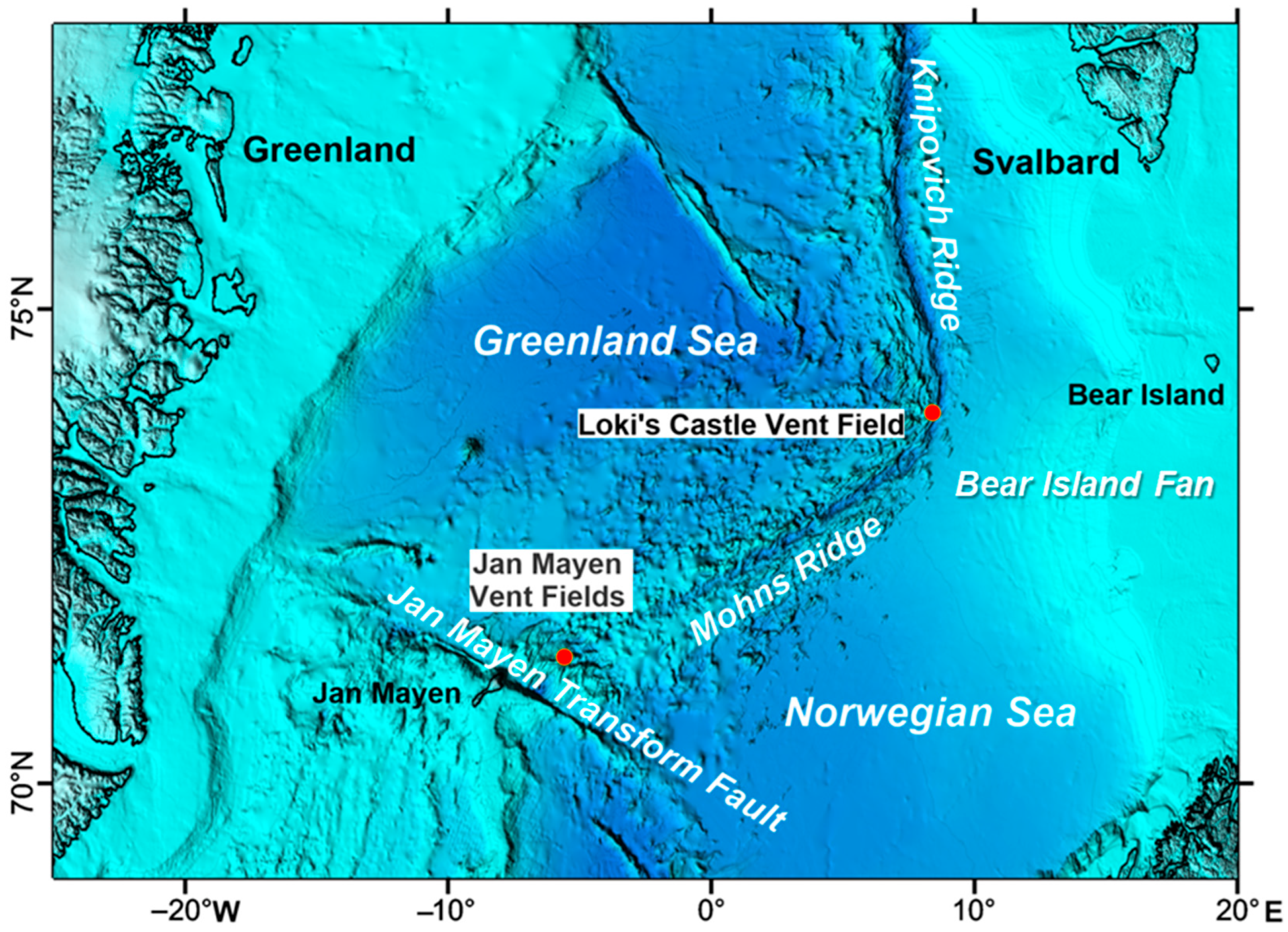

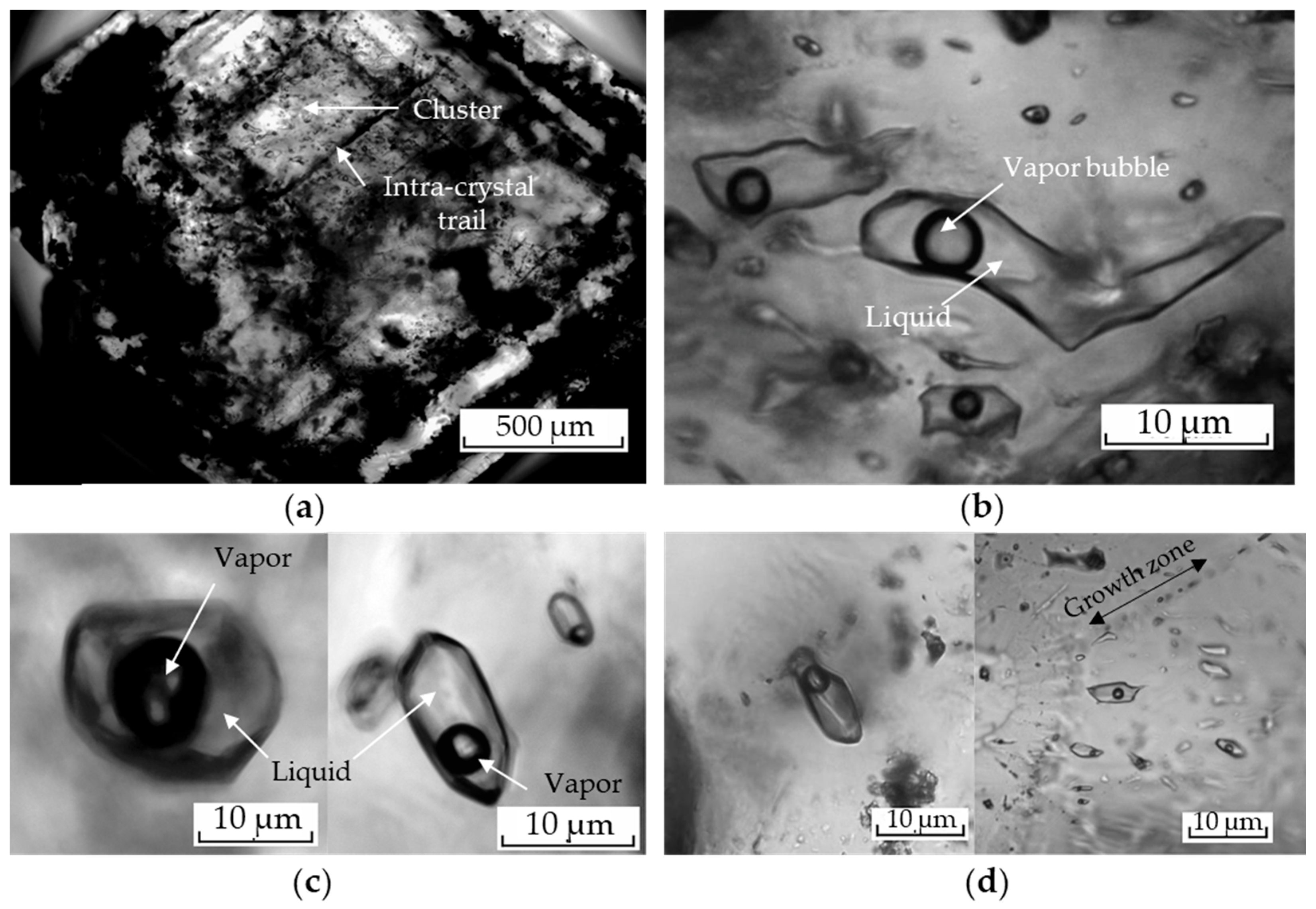
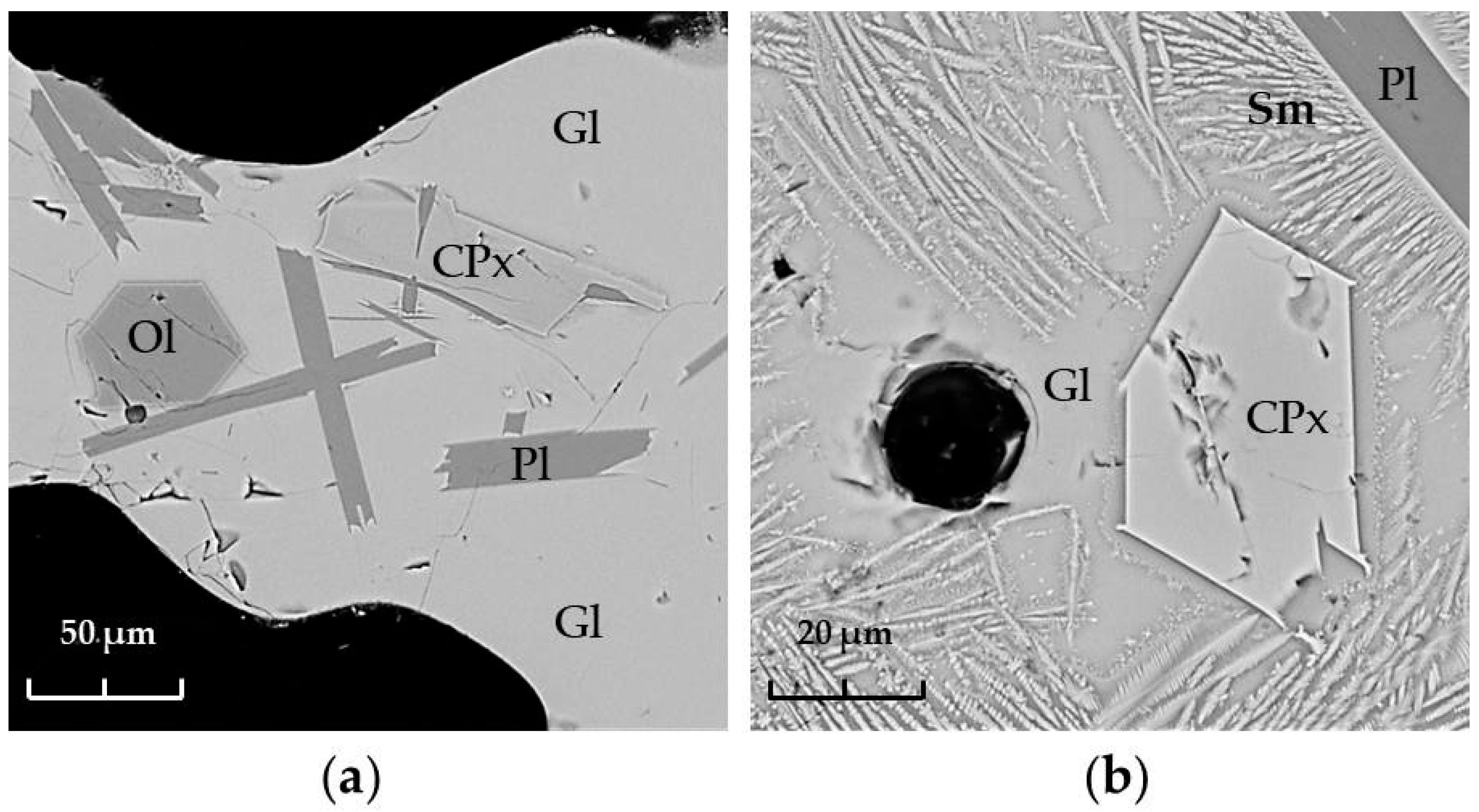


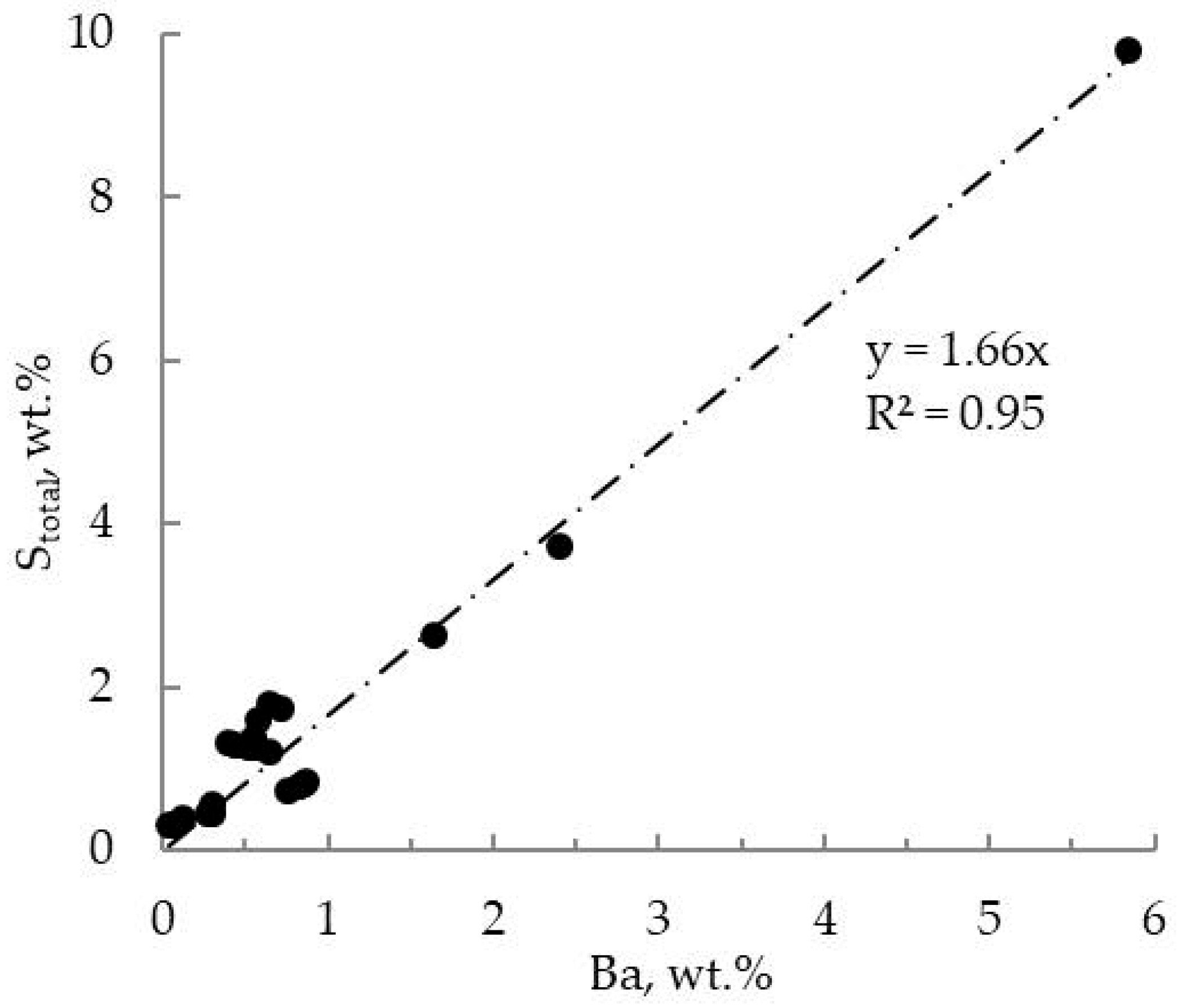
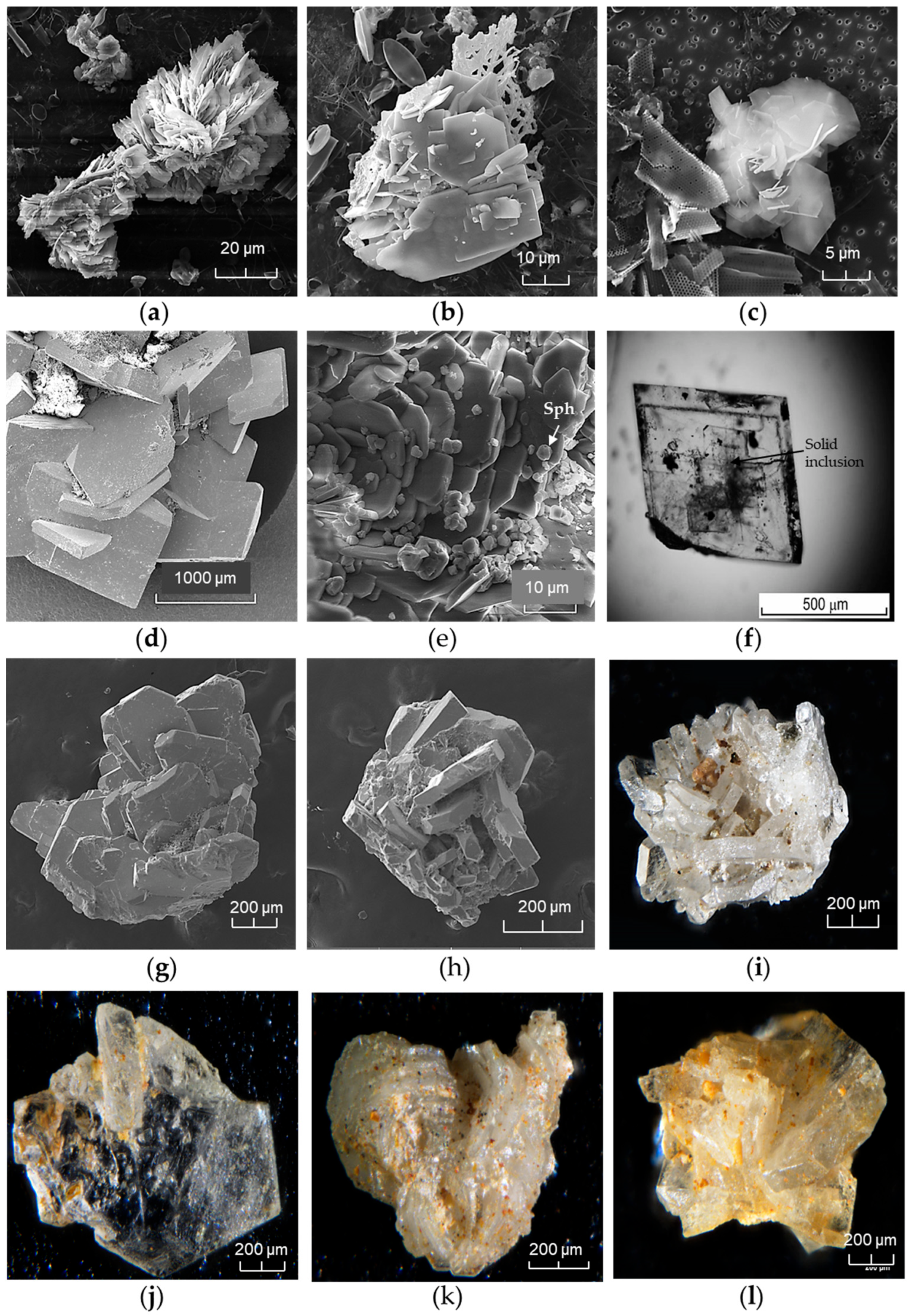
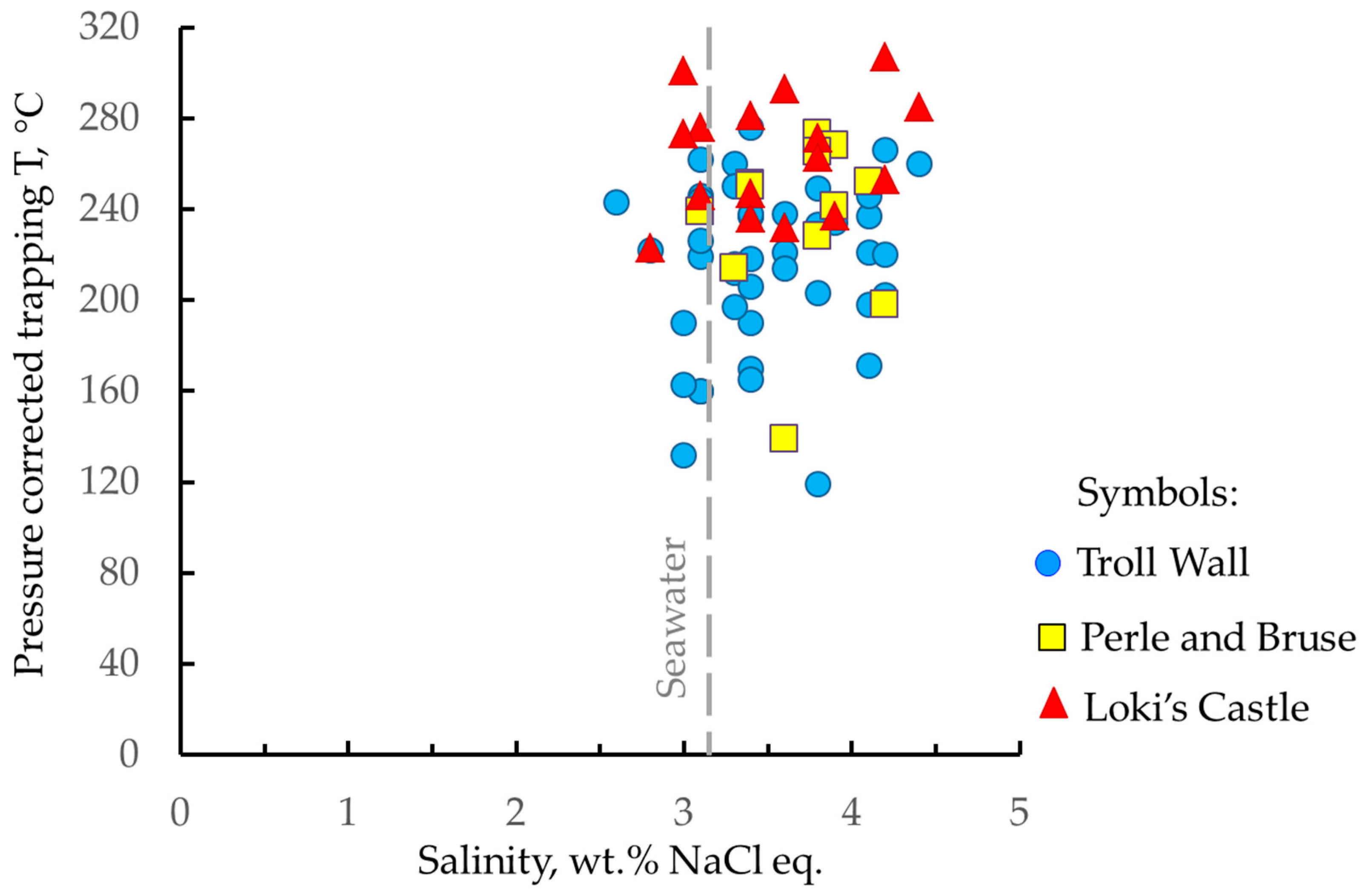

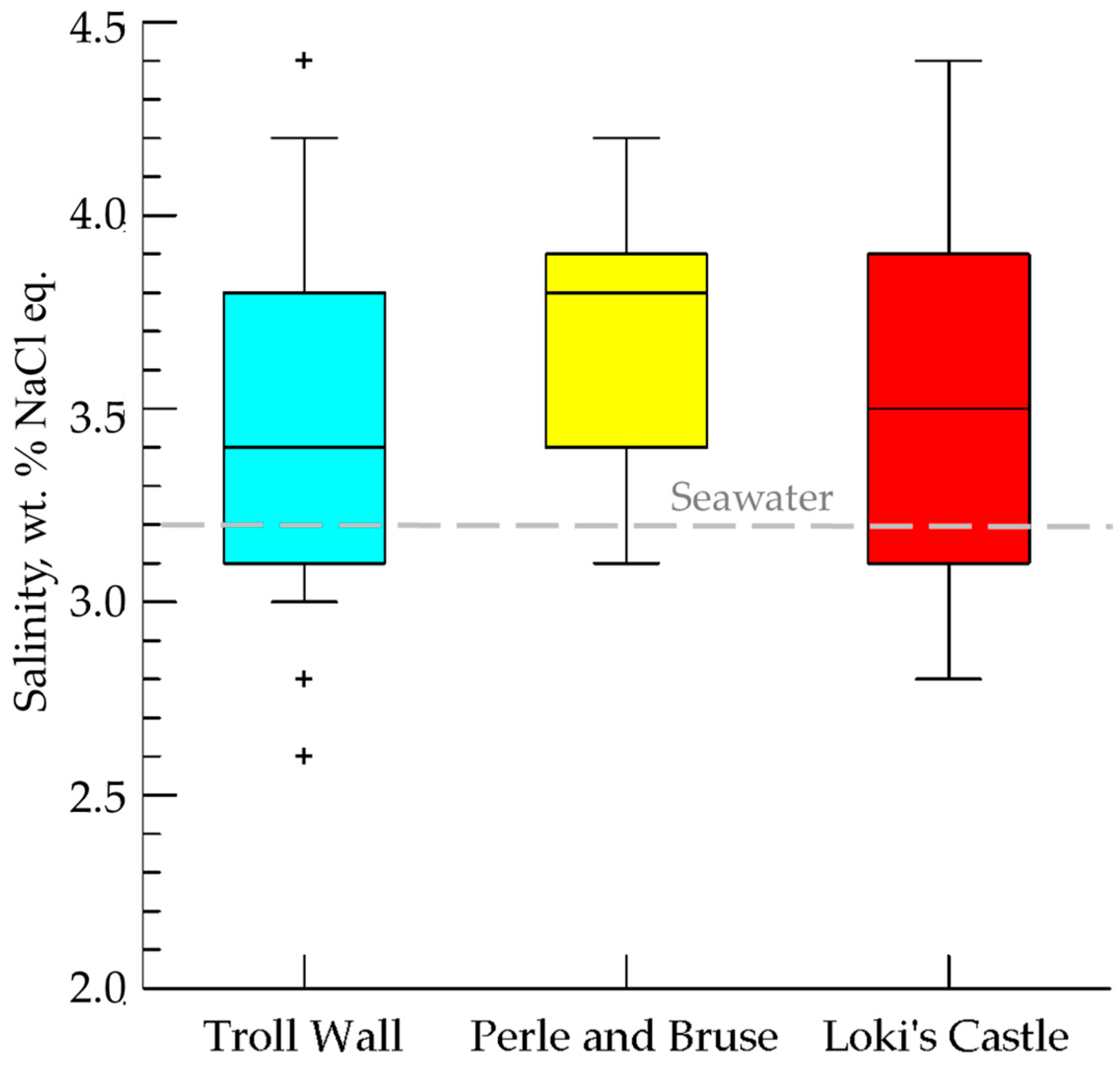
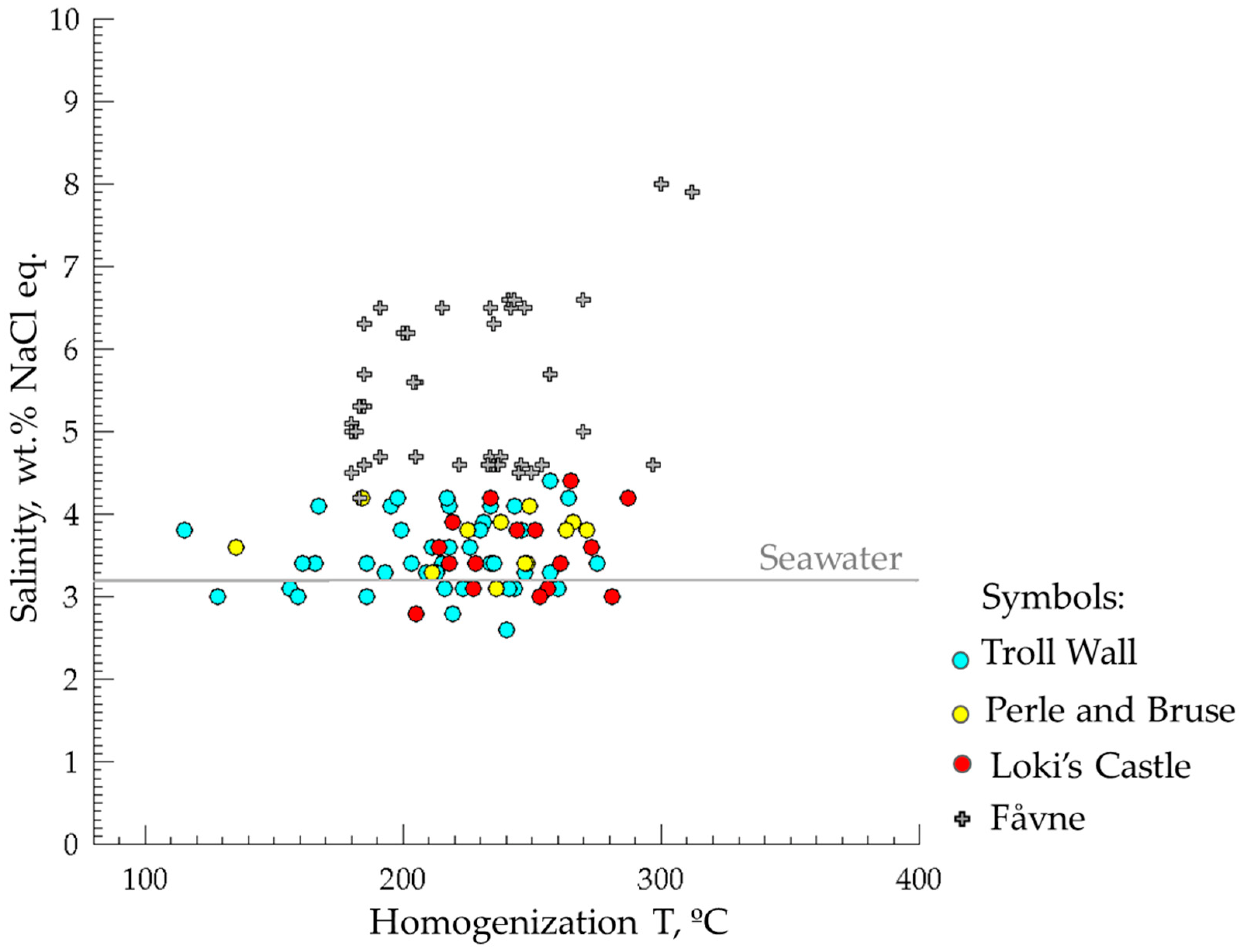
| Mineral | Formula | Abundance | Content Range, wt. % |
|---|---|---|---|
| Troll Wall, proximal sediments | |||
| Smectite | ()( ) ·nO * | Major | 15–62 |
| IIllite | K0.6–0.85(Al,Mg)2(Si,Al)4O10(OH)2 | Major | 1–10 |
| Fe-Si oxyhydroxides | Fe amorphous silica | Major | n.d. ** |
| Barite | Ba() | Major | 3–85 |
| Gypsum | CaSO4 2H2O | Major | 1–11 |
| Pyrite | (cubic) | Major | 4–99 |
| Marcasite | (orthorhombic) | Major | 4–87 |
| Sphalerite | ZnS (cubic) | Major | 1–10 |
| Chalcopyrite | CuFeS2 | Minor | 1–2 |
| Birnessite | (Na,Ca)0.5(Mn4+,Mn3+)2O4 1.5H2O | Minor | n.d. |
| Buserite | Na4Mn14O27 21H2O | Minor | n.d. |
| Asbolane–Buserite | Mixed-layer Mn formation | Minor | n.d. |
| Chlorite–smectite | Mixed-layer clay formation | Minor | 0–37 |
| Wurtzite | (Zn)S (hexagonal) | Rare | 2–5 |
| Goethite | α-FeO(OH) | Rare | 1–53 |
| Lepidocrocite | ɣ-FeO(OH) | Rare | 0–25 |
| X-ray amorphous clay | Ultrafine structurally defective clay formation | Rare | n.d. |
| Mordenite | (,Ca,)4() 28O | Rare | 0–93 |
| Jarosite | K(SO4)2(OH)6 | Rare | 13 |
| Chlorite | ()5Al(Si3Al)O10(OH)8 | Rare | n.d. |
| Perle and Bruse, distal sediments | |||
| Smectite | ()() ·nO | Major | n.d. |
| IIllite | K0.6–0.85(Al,Mg)2(Si,Al)4O10(OH)2 | Major | 3–8 |
| Barite | Ba() | Major | 1–6 |
| Gypsum | CaSO4 2H2O | Major | 1–6 |
| Birnessite | (Na,Ca)0.5(Mn4+,Mn3+)2O4 1.5H2O | Major | n.d. |
| Buserite | Na4Mn14O27 21H2O | Major | n.d. |
| Fe-oxides | X-ray amorphous Fe2O3 | Major | n.d. |
| Pyrite | (cubic) | Minor | 1–2 |
| Smectite–illite | Mixed-layer clay formation | Rare | 2–4 |
| Chlorite | ()5Al(Si3Al)O10(OH)8 | Rare | 2–3 |
| Buserite | Na4Mn14O27 · 21H2O, heat resistant | Rare | n.d. |
| Asbolane | O | Rare | n.d. |
| Asbolane–Buserite | Mixed-layer Mn formation | Rare | n.d. |
| Loki’s Castle, proximal sediments | |||
| Smectite | ()() nO | Major | 10–30 |
| Talc | Major | 1–95 | |
| Pyrite | (cubic) | Major | 3–18 |
| Marcasite | FeS2 (orthorhombic) | Minor | 3–30 |
| Pyrrhotite (hexagonal) | S | Major | 5–81 |
| Pyrrhotite (monoclinic) | S | Minor | 5–15 |
| Sphalerite | ZnS (cubic) | Major | 2–13 |
| Chalcopyrite | CuFeS2 | Major | 2–75 |
| Barite | Ba() | Major | 2–28 |
| Native sulfur | S | Major | 4–34 |
| Goethite | α-FeO(OH) | Major | 3–18 |
| Lepidocrocite | ɣ-FeO(OH) | Minor | 1–24 |
| Chlorite–smectite | Mixed-layer clay formation | Minor | n.d. |
| Talc-like mineral–smectite | Mixed-layer formation with Mg-Fe phyllosilicate | Minor | n.d. |
| Gypsum | CaSO4 2H2O | Minor | 1–8 |
| Chlorite | ()5Al(Si3Al)O10(OH)8 | Rare | n.d. |
| Galena | PbS | Rare | 2–3 |
| Famatinite | Cu3SbS4 | Rare | 0–4 |
| Paratacamite | Cu3(Cu, Zn)(OH)6Cl2 | Rare | 0–58 |
| Jarosite | K()2 | Rare | 0–35 |
| Station, Depth, Layer | Type of FIs * | n | Thom, °C | Teut, °C | Tice melt, °C | Salinity, wt.% NaCl eq. | d, g·cm−3 | T **, °C | Tcryst ***, °C |
|---|---|---|---|---|---|---|---|---|---|
| Troll Wall vent field, depth of 512–600 m | |||||||||
| 6131 | P | 8 | 275 | −33 | −2.1 | 3.4 | 0.80 | 1 | 276 |
| 512 m | P | 4 | 246 | −31 | −2.3 | 3.8 | 0.84 | 3 | 249 |
| 0–20 cm | P | 4 | 218 | −33 | −2.5 | 4.1 | 0.88 | 3 | 221 |
| P | 5 | 217 | −31 | −2.6 | 4.2 | 0.88 | 3 | 220 | |
| P−S | 3 | 195 | −31 | −2.5 | 4.1 | 0.90 | 3 | 198 | |
| P−S | 2 | 167 | −25 | −2.5 | 4.1 | 0.93 | 4 | 171 | |
| S | 2 | 115 | −27 | −2.3 | 3.8 | 0.98 | 4 | 119 | |
| 6131 | P | 7 | 264 | −33 | −2.6 | 4.2 | 0.82 | 2 | 266 |
| 512 m | P | 6 | 234 | −32 | −2.1 | 3.4 | 0.85 | 3 | 237 |
| 1–9 cm | P | 5 | 234 | −32 | −2.1 | 3.4 | 0.85 | 3 | 237 |
| P | 8 | 216 | −31 | −1.9 | 3.1 | 0.87 | 3 | 219 | |
| P | 6 | 215 | −34 | −2.1 | 3.4 | 0.88 | 3 | 218 | |
| P−S | 5 | 186 | −33 | −2.1 | 3.4 | 0.91 | 4 | 190 | |
| S | 3 | 156 | −34 | −1.9 | 3.1 | 0.94 | 4 | 160 | |
| S | 6 | 156 | −32 | −1.7 | 3.1 | 0.94 | 4 | 160 | |
| 6137 | P | 8 | 234 | −33 | −2.5 | 4.1 | 0.86 | 3 | 237 |
| 600 m | P | 6 | 231 | −34 | −2.4 | 3.9 | 0.86 | 3 | 234 |
| 0–5 cm | P | 7 | 230 | −32 | −2.3 | 3.8 | 0.86 | 3 | 233 |
| P | 4 | 223 | −30 | −1.9 | 3.1 | 0.86 | 3 | 226 | |
| P | 10 | 219 | −32 | −1.7 | 2.8 | 0.87 | 3 | 222 | |
| P | 6 | 218 | −30 | −2.2 | 3.6 | 0.87 | 3 | 221 | |
| P | 5 | 213 | −34 | −2.0 | 3.3 | 0.88 | 3 | 216 | |
| P | 7 | 211 | −33 | −2.2 | 3.6 | 0.88 | 3 | 214 | |
| P−S | 5 | 193 | −31 | −2.0 | 3.3 | 0.90 | 4 | 197 | |
| P−S | 5 | 166 | −32 | −2.1 | 3.4 | 0.93 | 5 | 170 | |
| P−S | 3 | 161 | −33 | −2.1 | 3.4 | 0.93 | 4 | 165 | |
| S | 4 | 159 | −30 | −1.8 | 3.0 | 0.93 | 4 | 163 | |
| 5516 | P | 3 | 260 | −35 | −1.9 | 3.1 | 0.81 | 2 | 262 |
| 540 m | P | 2 | 257 | −30 | −2.0 | 3.3 | 0.82 | 3 | 260 |
| 0–3 cm | P | 2 | 257 | −34 | −2.7 | 4.4 | 0.83 | 3 | 260 |
| P | 16 | 247 | −33 | −2.0 | 3.3 | 0.83 | 3 | 250 | |
| P | 3 | 243 | −31 | −2.5 | 4.1 | 0.85 | 3 | 246 | |
| P | 5 | 243 | −32 | −1.9 | 3.1 | 0.84 | 3 | 246 | |
| P | 3 | 241 | −31 | −1.9 | 3.1 | 0.84 | 3 | 244 | |
| P | 2 | 240 | −32 | −1.6 | 2.6 | 0.84 | 3 | 243 | |
| P | 2 | 235 | −32 | −2.1 | 3.4 | 0.85 | 3 | 238 | |
| P | 4 | 226 | −32 | −2.2 | 3.6 | 0.86 | 3 | 238 | |
| P | 8 | 209 | −30 | −2.0 | 3.3 | 0.88 | 3 | 212 | |
| P | 3 | 203 | −32 | −2.1 | 3.4 | 0.89 | 3 | 206 | |
| P | 5 | 199 | −31 | −2.3 | 3.8 | 0.90 | 4 | 203 | |
| P | 5 | 198 | −33 | −2.6 | 4.2 | 0.90 | 4 | 202 | |
| P | 4 | 186 | −33 | −1.8 | 3.0 | 0.91 | 4 | 190 | |
| P | 2 | 128 | −30 | −1.8 | 3.0 | 0.96 | 4 | 132 | |
| Range | 115–275 | −35–−25 | −2.7–−1.6 | 2.6–4.4 | 0.80–0.98 | 1–5 | 119–276 | ||
| Perle and Bruse vent field, depth of 620 m | |||||||||
| 6146 | P | 3 | 271 | −30 | −2.3 | 3.8 | 0.80 | 2 | 273 |
| 620 m | P | 4 | 266 | −34 | −2.4 | 3.9 | 0.81 | 2 | 268 |
| 0–9 cm | P | 6 | 263 | −32 | −2.3 | 3.8 | 0.81 | 2 | 265 |
| P | 4 | 249 | −31 | −2.5 | 4.1 | 0.84 | 3 | 252 | |
| P | 3 | 248 | −31 | −2.1 | 3.4 | 0.83 | 3 | 251 | |
| P | 3 | 247 | −27 | −2.1 | 3.4 | 0.83 | 3 | 250 | |
| P | 6 | 238 | −34 | −2.4 | 3.9 | 0.85 | 3 | 241 | |
| P | 7 | 236 | −32 | −1.9 | 3.1 | 0.83 | 3 | 239 | |
| P−S | 4 | 225 | −33 | −2.3 | 3.8 | 0.87 | 3 | 228 | |
| P−S | 5 | 211 | −32 | −2.0 | 3.3 | 0.88 | 3 | 214 | |
| P−S | 2 | 184 | −30 | −2.6 | 4.2 | 0.92 | 4 | 198 | |
| S | 3 | 135 | −28 | −2.2 | 3.6 | 0.96 | 4 | 139 | |
| Range | 135–271 | −34–−27 | −2.6–−1.9 | 3.1–4.2 | 0.80–0.96 | 2–4 | 139–273 | ||
| Loki’s Castle vent field, depth of 2376 m | |||||||||
| 6147 | P | 13 | 287 | −32 | −2.6 | 4.2 | 0.78 | 20 | 307 |
| 2376 m | P | 4 | 281 | −35 | −1.8 | 3.0 | 0.77 | 20 | 301 |
| 0–12 cm | P | 7 | 273 | −32 | −2.2 | 3.6 | 0.79 | 20 | 293 |
| P | 2 | 265 | −31 | −2.7 | 4.4 | 0.82 | 20 | 285 | |
| P | 4 | 261 | −33 | −2.1 | 3.4 | 0.81 | 20 | 281 | |
| P | 5 | 256 | −34 | −1.9 | 3.1 | 0.82 | 20 | 276 | |
| P | 6 | 253 | −33 | −1.8 | 3.0 | 0.82 | 20 | 273 | |
| P | 2 | 251 | −33 | −2.3 | 3.8 | 0.83 | 20 | 271 | |
| P | 3 | 244 | −30 | −2.3 | 3.8 | 0.84 | 19 | 263 | |
| P | 9 | 234 | −35 | −2.6 | 4.2 | 0.86 | 19 | 253 | |
| P | 6 | 228 | −34 | −2.1 | 3.4 | 0.86 | 19 | 247 | |
| P−S | 2 | 227 | −30 | −1.9 | 3.1 | 0.86 | 19 | 246 | |
| P−S | 6 | 219 | −31 | −2.4 | 3.9 | 0.88 | 18 | 237 | |
| P−S | 7 | 218 | −31 | −2.1 | 3.4 | 0.87 | 18 | 236 | |
| P−S | 5 | 214 | −33 | −2.2 | 3.6 | 0.88 | 18 | 232 | |
| P−S | 7 | 205 | −32 | −1.7 | 2.8 | 0.88 | 18 | 223 | |
| Range | 205–287 | −35–−30 | −2.7–−1.7 | 2.8–4.4 | 0.77–0.86 | 8–20 | 223–307 | ||
| Grain | Ba | Sr | Ca | Fe | Co | S | O | Total |
|---|---|---|---|---|---|---|---|---|
| Hydrothermally altered sediments of Troll Wall | ||||||||
| 1 | 57.60 | 1.99 | 0.26 | 0.44 | n.d. | 14.68 | 24.53 | 99.50 |
| 2 | 55.58 | 3.20 | 0.21 | 0.71 | n.d. | 15.14 | 26.53 | 101.37 |
| 3 | 57.69 | 1.33 | n.d. * | 0.51 | n.d. | 14.62 | 25.52 | 99.68 |
| 4 | 57.19 | 2.03 | n.d. | 0.93 | n.d. | 15.13 | 25.95 | 101.24 |
| 5 | 56.03 | 2.79 | n.d. | 0.60 | n.d. | 14.84 | 23.80 | 98.06 |
| 6 | 58.28 | 1.18 | n.d. | 0.57 | n.d. | 14.66 | 25.47 | 100.15 |
| Mean | 57.06 | 2.09 | 0.24 | 0.63 | - | 14.85 | 25.30 | 100.16 |
| Buoyant hydrothermal plume of Troll Wall | ||||||||
| 7 | 66.78 | 1.70 | 0.40 | n.d. | n.d. | 14.41 | 16.71 | 100.00 |
| 8 | 50.10 | 1.41 | 0.49 | n.d. | n.d. | 13.87 | 30.67 | 96.54 |
| 9 | 41.49 | 5.32 | 1.30 | n.d. | n.d. | 15.89 | 35.25 | 99.25 |
| Mean | 52.79 | 2.81 | 0.73 | - | - | 14.72 | 27.54 | 98.59 |
| Hydrothermally altered sediments of Loki’s Castle | ||||||||
| 10 | 63.36 | 0.59 | 0.05 | 0.16 | 0.28 | 13.86 | 29.26 | 107.55 |
| 11 | 61.49 | 0.43 | 0.18 | 0.01 | 0.08 | 15.48 | 23.67 | 101.34 |
| 12 | 61.37 | 0.22 | n.d. | 0.10 | n.d. | 13.69 | 19.53 | 94.91 |
| 13 | 61.32 | n.d. | 0.15 | 0.30 | 0.24 | 14.15 | 24.15 | 100.31 |
| 14 | 63.24 | n.d. | 0.03 | 0.31 | n.d. | 15.09 | 23.38 | 102.05 |
| 15 | 59.49 | 0.03 | 0.01 | 0.17 | 0.03 | 16.85 | 29.37 | 106.95 |
| 16 | 57.76 | 0.94 | 0.10 | 0.29 | n.d. | 13.25 | 30.20 | 102.53 |
| Mean | 61.15 | 0.44 | 0.09 | 0.19 | 0.16 | 14.62 | 25.65 | 102.23 |
| Buoyant hydrothermal plume of Loki’s Castle | ||||||||
| 17 | 50.16 | 5.07 | 1.54 | n.d. | 0.04 | 14.37 | 29.88 | 99.96 |
| Vent Field | Location | Depth, m | Deposit Type | Fluid Salinity, wt.% NaCl eq. | Fluid T *, °C | Comment | Reference |
|---|---|---|---|---|---|---|---|
| Troll Wall | 71°18′ N, Mohns Ridge, AMOR | 550 | Chimney edifices | n.d. ** | 260–270 | Direct measurements. | [32] |
| 512–600 | Hydrothermally altered sediments | 2.6–4.4 | 119–276 | Primary and secondary FIs in barite. Fluid phase separation (FPS) is indicated. | This work | ||
| Bruse | 71°18′ N, Mohns Ridge, AMOR | 561 | Barite-rich chimney edifices | ~2.6 | 240–242 | Direct measurements: maximum temperature. FPS is indicated. | [56] |
| 560 | Barite-rich chimney edifices | ~2.5 | 229–270 | Direct measurements. FPS is indicated. | [79] | ||
| Perle and Bruse | 71°18′ N, Mohns Ridge, AMOR | 620 | Hydrothermally altered sediments | 3.1–4.2 | 139–273 | Primary and primary–secondary FIs in barite. FPS is indicated. | This work |
| Soria Moria | 71°15′ N, Mohns Ridge, AMOR | ~700 | Chimney edifices | ~3.1 | 50–270 | Direct measurements. | [79] |
| Loki’s Castle | 73°30′ N, Mohns Ridge, AMOR | ~2000 | Talc-anhydrite chimney edifices | ~2.9 | 280–317 | Direct measurements. FPS is indicated. | [33] |
| 2376 | Hydrothermally altered sediments | 2.8–4.4 | 223–307 | Primary and secondary FIs in barite. FPS is indicated. | This work | ||
| Fåvne | 72°45′ N, Mohns Ridge, AMOR | ~3000 | Seafloor massive sulfide | 4.2–8.0 | 200–291 | Primary FIs in anhydrite. Fluid did not experience significant mixing with seawater. | [37] |
| Menez Gwen | 37°50′ N, MAR, influenced by the Azores hot spot | 847–871 | Anhydrite and Anhydrite-barite edifices with disseminated sulfides | 2.2–2.3 | 271–284 | Direct measurements. FPS is indicated. | [22] |
| Lucky Strike | 37° N, MAR, influenced by the Azores hot spot | 1618–1730 | Sulfate-sulfide deposits | 2.9–3.5 | 202–325 | Direct measurements. Evidence for FPS. | [72] |
| Rainbow | 36°14′ N and 33°54′ W, MAR | 2270–2320 | Sulfide edifices and fields associated with serpentinites | 4.5–7.7 | 295–370 | Primary FIs in anhydrite are associated with marcasite and chalcopyrite. FPS is proposed. | [80] |
| Broken Spur | 29°10′ N, 43°10′ W, MAR | ~3000 | Sulfide chimney, walls of a tube | 3.0–6.3 | 259–406 | Primary FIs in anhydrite. FPS is indicated. | [77] |
| TAG | 26°08′ N, MAR | 3670 | Volcanogenic massive sulfides, edifices | 1.2–5.1 | 187–390 | Primary FIs in anhydrite. FPS is indicated. | [86] |
| Breccia, veins, quartz, massive granular pyrite | 1.9–6.2 | 212–390 | Primary FIs in anhydrite and quartz. FPS is indicated. | [87] | |||
| Logachev-1 | 14°45′ N, MAR | 2970 | Sulfide chimney, walls of a tube | 4.2–16.2 (max 26) | 271–365 | Primary FIs in anhydrite. FPS is indicated. | [77] |
| 1.9–6.2 | 212–390 | Primary FIs in anhydrite and quartz. FPS is indicated. | [87] | ||||
| Semenov-1 | 13°30′ N, MAR | 2400–2950 | Barite-rich massive sulfides | 0.6–3.8 | 83–244 | Primary FIs in barite. FPS is indicated. | [25] |
| Ashadze 1, Long Chimney | 12°58′ N, MAR | 4080 | Sulfide edifices | 5.0–7.0 | 295–345 | Primary FIs in anhydrite. FPS is indicated. | [88] |
| Embryo sulfide edifices | 5.0–7.8 | 235–355 | Primary FIs in anhydrite. FPS is indicated. | [88] | |||
| JADE | Central Okinawa Trough, NW Pacific. Back-arc basin. | 1300–1600 | Sulfide-sulfate chimneys and mounds. Stockwork mineralizations. | 4.4–9.6 | 220–320 | Primary FIs in gypsum and barite. | [89] |
| 2.0–15.0 | 270–360 | Primary FIs in sphalerite. FPS is indicated. | [11] | ||||
| Endeavour Segment | Juan de Fuca Ridge, NE Pacific | 2050–2700 | Barite-rich sulfide edifices | 5.7–9.4 | 124–283 | Primary FIs in barite. FPS is not confirmed. | [18] |
| Vienna Wood | 3°10′ S, 150°17′ E, Manus basin, SW Pacific | ~2500 | Barite-silica-sulfide chimney, top of an active tube | 4.7–7.6 | 165–235 | Primary and secondary FIs in barite. FPS is indicated. | [77] |
| 5.3–7.2 | 242–324 | Primary FIs in anhydrite. FPS is indicated. | [77] | ||||
| 4.1–8.5 | 160–247 | Primary FIs in anhydrite are associated with chalcopyrite and sphalerite. FPS is proposed. | [80] | ||||
| Franklin seamount | 9°55′ S, 151°50′ E, Woodlark basin, SW Pacific | 2143–2366 | Barite-sulfide edifices | 2.7–6.9 | 203–316 | Primary FIs in barite. FPS is indicated. | [77] |
| Lau back arc basin | 19°20′–22°50′ S, Valu Fa Ridge, Tonga arc, SW Pasific | 1735 | White Church, barite-sulfide chimneys | 1.6–2.6 | 170–230 | Primary FIs in barite. FPS is indicated. | [23] |
| Hook Ridge | 62°11′ S, 57°15′ W, Bransfield Strait, Antarctica | 990 | Chimney and massive barite slab. Arc-shaped composite volcano | 0.9–4.2 | 132–310 | Primary FIs in barite. FPS is indicated. | [81] |
Disclaimer/Publisher’s Note: The statements, opinions and data contained in all publications are solely those of the individual author(s) and contributor(s) and not of MDPI and/or the editor(s). MDPI and/or the editor(s) disclaim responsibility for any injury to people or property resulting from any ideas, methods, instructions or products referred to in the content. |
© 2023 by the authors. Licensee MDPI, Basel, Switzerland. This article is an open access article distributed under the terms and conditions of the Creative Commons Attribution (CC BY) license (https://creativecommons.org/licenses/by/4.0/).
Share and Cite
Kravchishina, M.D.; Prokofiev, V.Y.; Dara, O.M.; Baranov, B.V.; Klyuvitkin, A.A.; Iakimova, K.S.; Kalgin, V.Y.; Lein, A.Y. Fluid Inclusion Studies of Barite Disseminated in Hydrothermal Sediments of the Mohns Ridge. Minerals 2023, 13, 1117. https://doi.org/10.3390/min13091117
Kravchishina MD, Prokofiev VY, Dara OM, Baranov BV, Klyuvitkin AA, Iakimova KS, Kalgin VY, Lein AY. Fluid Inclusion Studies of Barite Disseminated in Hydrothermal Sediments of the Mohns Ridge. Minerals. 2023; 13(9):1117. https://doi.org/10.3390/min13091117
Chicago/Turabian StyleKravchishina, Marina D., Vsevolod Yu. Prokofiev, Olga M. Dara, Boris V. Baranov, Alexey A. Klyuvitkin, Karina S. Iakimova, Vladislav Yu. Kalgin, and Alla Yu. Lein. 2023. "Fluid Inclusion Studies of Barite Disseminated in Hydrothermal Sediments of the Mohns Ridge" Minerals 13, no. 9: 1117. https://doi.org/10.3390/min13091117
APA StyleKravchishina, M. D., Prokofiev, V. Y., Dara, O. M., Baranov, B. V., Klyuvitkin, A. A., Iakimova, K. S., Kalgin, V. Y., & Lein, A. Y. (2023). Fluid Inclusion Studies of Barite Disseminated in Hydrothermal Sediments of the Mohns Ridge. Minerals, 13(9), 1117. https://doi.org/10.3390/min13091117








